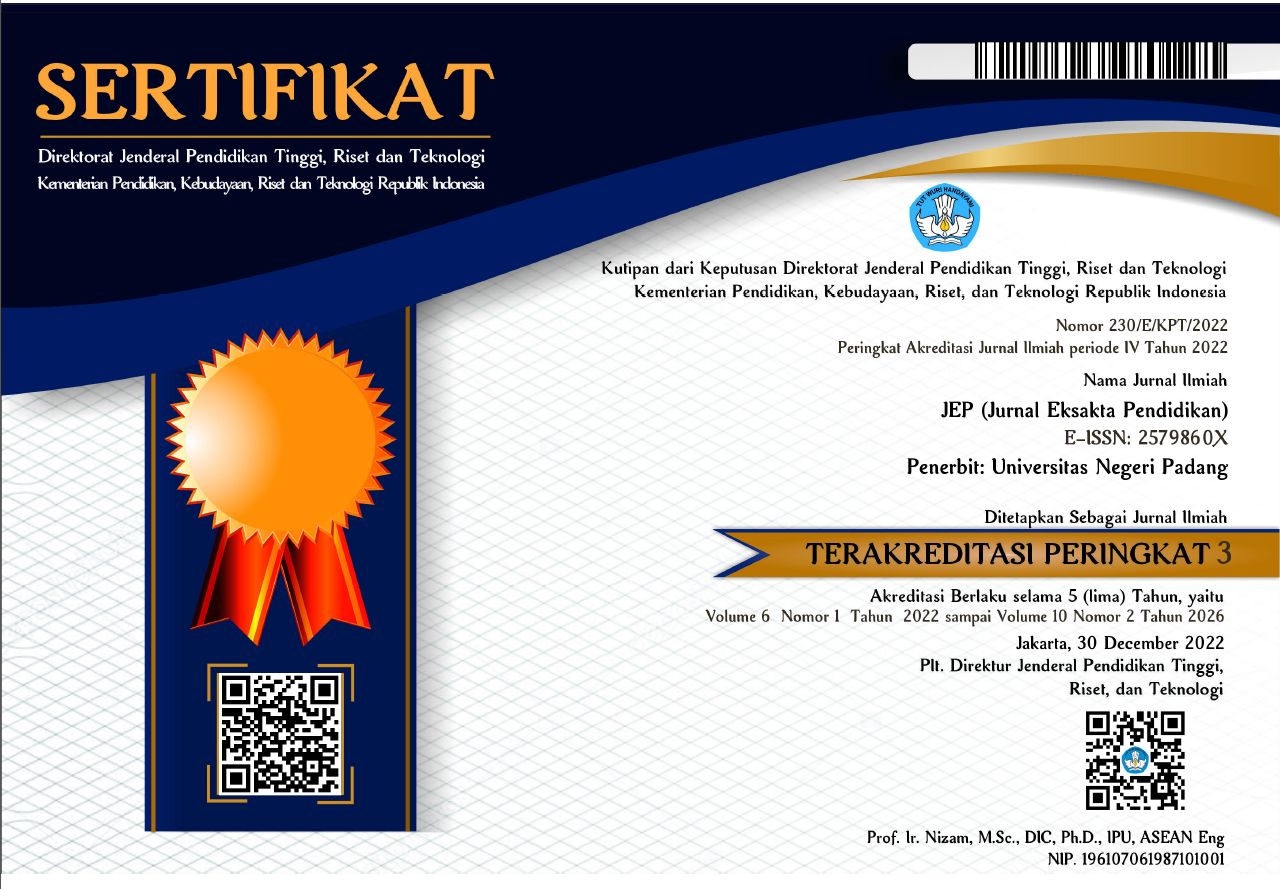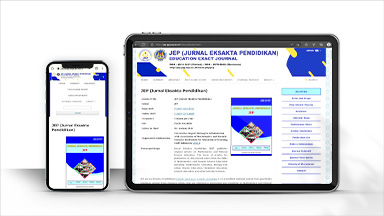Development of Electronic Handouts Using Numerical Literacy-Based Mathemagics Methods for Learning in the Digital Era
Abstract
This research is motivated and conducted to address the problem of low numeracy literacy among students and the limited electronic-based learning media with game-based methods. The urgency of this research is crucial because low numeracy literacy can affect students' ability to solve mathematical problems in their daily lives and the future. The lack of engaging learning media can also affect students' interest in learning. Therefore, this study aims to develop an electronic Mathemagic handout based on numeracy literacy. The development model used in this research is the DDD-E model. The developed handout product has been validated twice by material and media validators. After revising it based on their suggestions and inputs, the average validation score obtained is 87.1%. These results indicate that the developed electronic Mathemagic handout based on numeracy literacy meets the perfect validation criteria. The solution offered by this research is to develop an engaging mathematical learning media using game-based methods to improve students' numeracy literacy. It is hoped that the electronic Mathemagic handout based on numeracy literacy can help increase students' interest and learning ability in mathematics. As a result, students can be more confident and have sufficient ability to solve mathematical problems in their daily lives and the future. The study implies that educators and policymakers can consider implementing the electronic Mathemagic handout in their teaching methods to enhance students' numeracy, literacy, and interest in mathematics. Additionally, the study underscores the importance of using innovative and engaging approaches in teaching to foster a love for learning and improve academic outcomes.
Downloads
References
Aini, Q., Riza, B. S., Puji, N., Santoso, L., Faturahman, A., & Rahardja, U. (2020). Digitalization of Smart Student Assessment Quality in Era 4 . 0. International Journal of Advanced Trends in Computer Science and Engineering, 9(1), 257–265.
Akbar, S. (2013). Instrumen perangkat pembelajaran. Bandung: PT Remaja Rosdakarya.
Aunio, P., & Niemivirta, M. (2010). Predicting children’s mathematical performance in grade one by early numeracy. Learning and Individual Differences, 20(5), 427–435.
Cahyanovianty, A. D., & Wahidin. (2021). Analisis Kemampan Numerasi Peserta Didik Kelas VIII dalam Menyelesaikan Soal Asesmen Kompetensi Minimum. 05(02), 1439–1448.
Calvo, S. E., & Barrioluengo, M. S. (2016). The Influence of Early Literacy Competences on Later Mathematical Attainment: Evidence from TIMSS & PIRLS 2011 (Issue January).
Džumhur, Ž. (2022). Early Literacy and Numeracy Competencies: Predictors of Mathematics Achievement in the Dinaric Region. In IEA Research for Education (Vol. 13, pp. 101–122).
Feriyanto, F. (2022). Strategi Penguatan Literasi Numerasi Matematika Bagi Peserta Didik Pada Kurikulum Merdeka BELAJAR. Jurnal Gammath, 7(2), 86–94.
Fitriana, E., & Ridlwan, M. K. (2021). Pembelajaran Transformatif Berbasis Literasi Dan Numerasi Di Sekolah Dasar. TRIHAYU: Jurnal Pendidikan Ke-SD-An, 8(1), 1284–1291.
Gusteti, M. U., Martin, S. N., Indriani, N., Monalisa, S., Miftahurrisqi, U., & Permatasari, P. (2022). Peningkatan Kompetensi Guru dalam Membuat Media Pembelajaran Berbasis Teknologi Informasi di Masa Pandemi. 6(2), 277–284.
Gusteti, M. U., Martin, S. N., Matematika, P., & Matematika, P. (2020). Persepsi Mahasiswa Terhadap Penggunaan Media Prezi Pada Mata Kuliah Assessment Di Sd. 2(2), 9–16.
Gusteti, M. U., Rifandi, R., Gustya Manda, T., & Putri, M. (2021). The development of 3D animated video for mathematics learning in elementary schools. Journal of Physics: Conference Series, 1940(1), 012098.
Jamil, A. F., Cahyono, H., & Ayu, M. S. (2021). Pengembangan Handout Matematika Bercirikan Kearifan Lokal Untuk Meningkatkan Kemampuan Literasi Matematis. AKSIOMA: Jurnal Program Studi Pendidikan Matematika, 10(1), 48.
Kementerian Pendidikan dan Kebudayaan. (2021). Panduan Penguatan Literasi dan Numerasi di Sekolah.
Lefevre, J. A., Fast, L., Skwarchuk, S. L., Smith-Chant, B. L., Bisanz, J., Kamawar, D., & Penner-Wilger, M. (2010). Pathways to Mathematics: Longitudinal Predictors of Performance. Child Development, 81(6), 1753–1767.
Lukman, A., Hayati, D. K., & Hakim, N. (2019). Pengembangan Video Animasi Berbasis Kearifan Lokal p ada Pembelajaran I PA Kelas V d i Sekolah Dasar. Elementary Jurnal Ilmiah Pendidikan Dasar, 5(2), 153–166.
Ningtyas, R., Yunianta, T. N. H., & Wahyudi, W. (2014). Pengembangan Handout Pembelajaran Tematik Untuk Siswa Sekolah Dasar Kelas Iii. Scholaria : Jurnal Pendidikan Dan Kebudayaan, 4(3), 42.
Novitasari, D. (2022). Analisis Kemampuan Literasi Numerasi Pada Siswa Sekolah Dasar Negeri Di Kota Cirebon. repository.upi.edu.
Nurjanah, S., Arif, S., & Pd, M. (2021). Pengembangan Bahan Ajar Handout Elektronik Berbantuan Kvisoft Flipbook Maker Pro Materi Teks Fabel Kelas VII SMP. Jurnal Unimed, 10(2), 101–122.
Pangesti, F. T. P. (2018). Menumbuhkembangkan Literasi Numerasi Pada Pembelajaran Matematika Dengan Soal Hots. Indonesian Digital Journal of Mathematics and Education, 5(9), 566–575.
Perdana, R., & Suswandari, M. (2021). Literasi Numerasi Dalam Pembelajaran Tematik Siswa Kelas Atas Sekolah Dasar. 3(1), 9–15.
Putri, E. K., Gusteti, M. U., & Azmi, K. (2022). Pengembangan Media Pembelajaran Berbasis PBL Terintegrasi Karakter Percaya Diri untuk Meningkatkan Pemecahan Masalah Matematika SMA. Jurnal Eksakta Pendidikan (JEP), 6(2), 170-177.
Rifandi, R., Ahmad, D., & Gusteti, M. U. (2020). Praktikalitas Media Video Tutorial sebagai Suplemen Digital Learning pada Mata Kuliah Persamaan Diferensial Biasa. Jurnal Eksakta Pendidikan (JEP), 4(1), 27–33.
Sabri, I. (2019). Peran Pendidikan Seni Di Era Society 5 . 0 untuk Revolusi Industri 4.0. Seminar Nasional Pascasarjana 2019, 2(1), 342–347.
Sari, F. Y., Supriadi, N., Wahyu, R., Putra, Y., Tarbiyah, F., Raden, U. I. N., & Lampung, I. (2022). Model Pembelajaran CUPs Berbantuan Media Handout : Dampak terhadap Kemampuan Pemahaman Konsep Matematis ditinjau dari Gaya Kognitif Mosharafa : Jurnal Pendidikan Matematika Model pembelajaran CUPs didesain secara khusus untuk meningkatkan Mosharafa : Jurn. 11, 95–106.
Septiadi, M. I., Sudarman, S. W., & ES., Y. R. (2020). Pengembangan Handout dengan Pendekatan Pendidikan Matematika Realistik Indonesia (PMRI) untuk Memfasilitasi Penalaran Matematis. Jurnal Pendidikan Matematika Universitas Lampung, 8(4), 365–378.
Setyowati, L. (2013). Penggunaan Interactive handout berbasis Open Ended pada pembelajaran Himpunan untuk meningkatkan aktivitas belajar Matematika.
Skwarchuk, S. L., Sowinski, C., & LeFevre, J. A. (2014). Formal and Informal Home Learning Activities To Children’s Early Numeracy And Literacy Skills: Developing a Home Numeracy Model. Journal of Experimental Child Psychology, 121(1), 63–84.
Sugiyono, D. (2013). Metode Penelitian Kuantitatif, Kualitatif, dan Tindakan.
Sulisworo, D., Winarti, & Astuti, A. Y. (2020). Model Lingkungan Pembelajaran Era New Normal.
Wahyunita, M. (2017). Pengaruh Metode Mathemagics Terhadap Kemampuan Penalaran Matematis Ditinjau Dari Motivasi Belajar Siswa SMKN 1 Bandar Lampung. 93(I), 259.
Copyright (c) 2023 Meria Ultra Gusteti, Suci Wulandari, Widdya Rahmalina, Melani Putri, Elva Kurnia Putri

This work is licensed under a Creative Commons Attribution 4.0 International License.

This work is licensed under a Creative Commons Attribution 4.0 International License.




_(2579-860X).png)
_(2614-1221)1.png)




